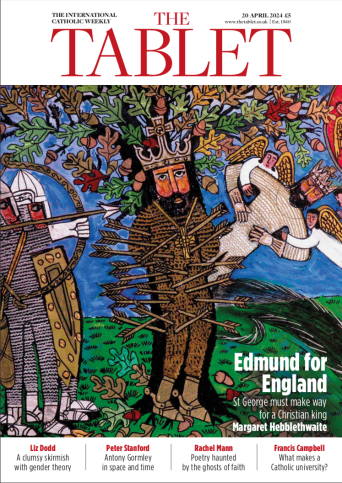It’s the “new” bit in the subtitle that caught my eye. I confess to a slight hurt, as when I offer to lend my teenage son a treasured jacket and he groans, “Oh, Dad, that’s so last century.” Some 18 years ago, I wrote my own biography of the Devil, and of course thought it very new at the time. But then publishers take the view that, every 20 years or so (or fewer if it’s the likes of Austen, Dickens or Churchill), every decent subject can be “done” again.
Putting to one side having become a back number, I did also wonder what there possibly might be to say about the Devil that hasn’t been said before. For 2,000 years he (or she, but even that is of course an angle that’s been done to death) has been discussed and debated, dissected and deconstructed, by theologians, academics, film-makers,
novelists, early church fathers, popes, bishops, inquisitors, exorcists, and all those seeking to scare the rest of us either into submission or simple sleeplessness.
So, what’s new? The answer, in the case of this concise volume by the professor emeritus of religion at the University of Queensland, is, I’m afraid, not very much. The “new-ness” here is about style rather than substance.
The tale that Philip Almond tells has been pretty well-charted already, peerlessly in the modern age by Professor Jeffrey Burton Russell of the University of California in his landmark five-volume history of the Devil. So Almond shows how there is no devil, as we now understand it, in the Old Testament, and how the emergence of Jesus’ tempter, with his demons, in the New Testament owes much to the extra-canonical literature that came in the time gap between the two parts of the Bible. Then he chronicles how the emerging Church and its influential “fathers” sought to fit the Devil into some sort of relationship with God, that allowed the latter to be utterly in control – Christianity being a monotheist (one God) religion, not a dualist one (opposite and equal gods of good and bad) – while at the same time allowing him some sort of rein to wreak havoc here on earth.
Naturally, Almond reaches his heyday with the medieval period, when the church authorities preyed on general fearfulness in uncertain times to warn that the Devil lurked round every corner, waiting to lure the unwary into a pact that would bring evil deeds to this world, but cause the individual damnation in the next. This, in its turn, became a means of control of the masses for a Church that often hoped to win the loyalty of its followers through fear – submission to its embrace was presented as the only chance of resisting the Devil and hence achieving salvation.
Such a mindset allowed, too, the terrible excesses of successive persecutions of all those who dared to step out of line with the Church – Cathar dissenters, Jews who refused to convert, or the awkward women who were labelled witches. They were all tarred with the brush of the Devil, and their alleged possession was sufficient to justify torture and murder.
To his credit, Almond tells this complicated story succinctly and clearly, taking us through all the twists and turns with an unwavering eye. The theology of the Devil bleeds into so many ideological battles between Christians, and is so infected by the politics, social forces and cultures of various ages, that it can be hard to avoid spending so much time painting in the context that the main thread of the narrative gets lost.
I only wish I had shown the same iron discipline. But there is something sacrificed too. For brevity’s sake, Almond misses out half the story. Hurried along this motorway of a narrative, I hankered for a B-road, if not a country lane – perhaps an entertaining aside on the Devil in the medieval mystery plays, for example, where the fearfulness with which he was usually regarded would often give way to a more comic presentation. An escape valve? Almond doesn’t have the time or space to waste on such diversions.
Almond comes to an abrupt halt at the dawn of the eighteenth century, as the medieval madness gives way to calmer Enlightenment speculation. He argues, in one sense very properly, that because the very notion of a living, breathing real Devil was being abandoned, the word “biography” can no longer apply. He is being too literal-minded, and will only leave readers with an itch to examine why the modern world refuses to abandon the concept of a devil-like figure to demonise others in our midst. “May she rot in hell,” screamed the tabloid headlines when Moors murderer Myra Hindley died. We make modern devils out of those whom we cannot readily understand, or who frighten or revolt us, and in so doing we continue to invoke the 2,000-year-old vocabulary of the Devil himself.
So a shorter biography, absolutely, but “new”? “It is to be hoped,” Almond concludes, “that this new biography of the Devil will go some way to restoring him to the central place that he has occupied in Western intellectual history for the better part of the last 2,000 years.” To achieve that goal, though, he really should have acknowledged that while his actual existence may be believed in literally by a dwindling number, the concept of the Devil is taken seriously by many more (including Pope Francis), and is used and readily understood by billions. There is still plenty of life left in the Devil.
31 July 2014, The Tablet
The Devil: a new biography
Edmund for England
 Loading ...
Loading ...
Get Instant Access
Subscribe to The Tablet for just £7.99
Subscribe today to take advantage of our introductory offers and enjoy 30 days' access for just £7.99



What do you think?
You can post as a subscriber user...
User Comments (0)